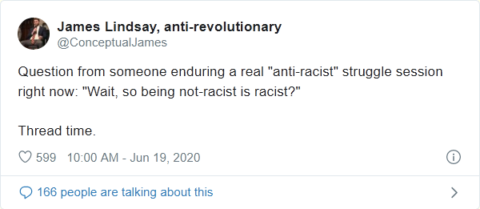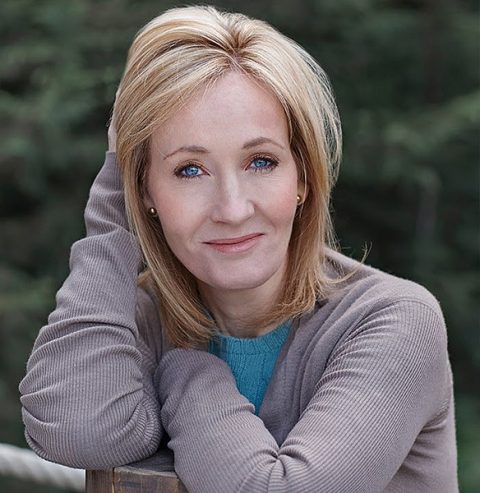A fascinating — and depressing — explanation of the core beliefs of those who subscribe to Critical Race Theory:
Question from someone enduring a real "anti-racist" struggle session right now: "Wait, so being not-racist is racist?"
Thread time.
— James Lindsay, anti-revolutionary (@ConceptualJames) June 19, 2020
Haha, yes. “Non-racist” means racist.
You have to understand that one of the primary axioms of this worldview is that everyone with racial privilege of any kind (including light-skinned black people, non-black people of color, etc.) is by definition always and constantly racist.
This is because they have defined “systemic racism” to mean more or less everything that happens, and, so long as there are any differences on average in racial outcomes, the system must be racist (privilege hierarchy noted: Asians and Jews doing well doesn’t count for anything).
You will have noticed that this means “systemic racism” in practice creates a state of perpetual victimhood for the “racially oppressed.” Anything that happens at all that isn’t to some complainer’s liking must have been the result of racism, and it’s their job to find it.
As we hear from Robin DiAngelo and her colleagues: “The question is not ‘did racism take place?’ but ‘how did racism manifest in this situation?'” The racism is absolutely certain to have taken place somewhere, according to this Woke worldview.
This is what “understanding race” and “racism” means when the Woke say it. What you have to understand is that everything contains racism, and a sufficiently skilled complainer can find it and leverage it against you. So, maybe they’re right. You have to understand race/racism.
Thus, more specifically, if you think you are “non-racist” or “less racist,” you’re not just racist, you’re the worst kind of racist. Robin DiAngelo says that in White Fragility explicitly. No exaggeration. That’s her definition for a white progressive or a “good white person.”
A lot of the relevant literature rails on “good white people” (there’s even a completely mental book by this title), “white liberals,” and “white progressives,” who are identified as the worst kinds of racists because they believe they’re not.
Good White: Translations From The Wokish
This entry in ‘Translations from the Wokish’ is an explanation of the term “Good White.” https://newdiscourses.com/tftw-good-white/
So, everyone under this insane rubric has to accept that they are racist and then decide how “anti-racist” they want to be. So, you can be a racist who is a little “anti-racist,” a lot “anti-racist,” or not “anti-racist,” but you cannot be “not racist” or “less racist.”
No matter how “anti-racist” you are, it will not make you not-racist in the end, even if you do it perfectly (impossible, explicitly) for your entire lives (required minimum time commitment, again, explicitly). And these people say their goal is to end racism. Seems odd.
You can’t even become “less racist” in this ideology. There’s no such thing, and to believe you are that is to make yourself more racist because you’re less aware of your need to constantly acknowledge your racism and try to dismantle the system in which it’s embedded.
Robin DiAngelo tells us that the goal is to become “less white,” not “less racist.” I’m not making that up. It’s right there in White Fragility, which millions of people are reading (and being forced to read) right now. Whiteness is the racist system, so that’s the goal.
Of course, all the literature also points out that it’s not possible to avoid benefiting from racial privilege (including white skin or white-passing appearance or light skin or white adjacency), so being “less white” is also impossible. It’s a self-shaming project instead.
Go back and read that like five times. It’s really the theory.
So when you take up “anti-racism,” you’re just signing on to a program they’ve outlined that has absolutely nothing to do with making people less racist, which is impossible. It’s crucial to understand this. “Social Justice” explicitly says it’s only about groups and systems.
Quote: “If democracy is about individual rights (justice for individuals), then social justice is about group rights (justice for groups). And for me there is a fundamental difference between the general notion of justice and the notion of social justice.”
Social Justice
This entry in ‘Translations from the Wokish’ is an explanation of the term “Social Justice.” https://newdiscourses.com/tftw-social-justice/So, “Social Justice” and thus “anti-racism” in that context is about making *the system* less racist, which is also impossible because the advocates of this Theory only measure by examining outcomes while looking for any and all problems in it.
Since “interest convergence” is one such problem, it’s sure to be found. This is the problem that makes it racist even for a racially privileged person to take up anti-racism. So, even being “anti-racist” increases one’s “racism” and the amount of “systemic racism” in the system.
Interest convergence is core Theory — mainstream Critical Race Theory, not fringe stuff. It says that racially privileged people only “do the right thing” by racially oppressed groups when it is also in their own self-interests. This is cynical in the extreme. Also, useless.
Interest convergence always moves the discussion of racism into hidden, terrible motivations and thus is an impediment to solving any problems of racism. Such impediments, though, are the fault of the racism in the system, not the terrible Theory, according to Theory.
So, even by trying ON THEIR (rather sadistic) TERMS you’re guaranteed not to be able to fix the racist system because fixing it is in the interests of racially dominant people which automatically perpetuates the racism in the system.
You’re also sure to notice that trying to fix a system is always guaranteed to leave out many, sometimes most, of the actual human beings within the system, at least if you still have a bit of your cortex outside of this paranoid way of thinking.
Why? The amount of knowledge and information processing necessary to perfect complex human systems vastly exceeds the processing power of any existing supercomputer, for starters. It just can’t be done.
Of course, our supercomputers vastly exceed the processing power of people who went to college to learn how critical thinking and systematic organization are features of white supremacy and not to be learned. So… there’s that.
So, even “anti-racism” is “racism,” and the whole thing is a giant fraud that’s being used to shake-down our institutions and corporations for the power and grift of the hustlers pushing it. Good people should be livid at this.
Have a nice day.
H/T to Aaron M. on MeWe for the link.







